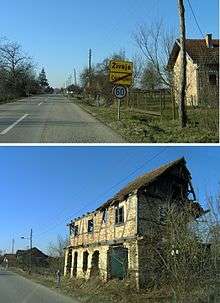Živaja
| Živaja | |
|---|---|
| Village | |
 Živaja Location of Živaja within Croatia | |
| Coordinates: 45°14′N 16°43′E / 45.233°N 16.717°ECoordinates: 45°14′N 16°43′E / 45.233°N 16.717°E | |
| Country | Croatia |
| County | Sisak-Moslavina |
| Area | |
| • Total | 30 km2 (10 sq mi) |
| Population (2011)[1] | |
| • Total | 309 |
| Time zone | CET (UTC+1) |
| • Summer (DST) | CEST (UTC+2) |
| Postal code | 44450 |
| Area code(s) | 044 |

Živaja is a village in central Croatia in Hrvatska Dubica, a municipality of Sisak-Moslavina County.
Geographical location
Živaja is located between Dubica and Sunja. Živaja village is 7 kilometers long and is one of the longest villages in the region. It is spread over approximately 30 square kilometers. Due to its position between two rivers, the Sava and Una, the village forms a horseshoe shape.
The village features "ušorenog type" (dense housing) as well as typical suburban housing on either side of a main road. The railroad extends parallel to the road in the direction of south-east north-west (direction Hr.Dubica-Sisak) on the right side of the road. This part of village is nearly flat and ideal lowland part. The right of the village is in the same flat; lowland continues for 1.5-2 km, to the great forest farms that extends back in the same valley to the Sava River. The left part of the road about 50-100 m is also the same plane on which supplements a gentle hills difference in altitude is not greater than 10-20 km compared to his village and this flat, and not too steep. Upon leaving the hilltops and again extends a plain, plateau, which extends about 4-5km and descends in Pounje (river valley Una).
Population
According to data gathered in 2001, the village has 484 inhabitants and approximately 290 houses. In 1991, Živaja had 726 residents, and in 1969 there were 800.
History
Of individual documents on population in this area, the Banovina, there is one from the year 1687. The document Croatian ban Nikola Erdödy call Zagreb Bishop Martin Borkovića to allow colonization by Serbs Bović and Kirin, which were in possession bishops. Sometime later Petrinjska count Erdödy Francis, the year 1693. sets Prince Peter Draskovic for chief Serbs in Slabinji and other surrounding areas. Lower Banovina had their possessions the family of Croatian nobles Keglević. Because of their possessions around Blinje they were with the sukobljavali constantly Turks. For this reason, Croatian aristocrat Peter Keglević inhabits Wallachian families around Petrinja. The year 1697. leads Vlahe wrong. That same year, Serbs are settled in and around Sunja. Two years later, in 1699 was inhabited by Živaja.
After World War II population in the village focused mainly agricultural production and livestock breeding as the primary branches. The country's economy is run in a very primitive way, using animals to assist in a lot of human work. Were to chipped households, with a small number of livestock and small land parcel. Owing to its very difficult work, people were able to vegetate and recover from the terrors of war (1945 whole village was in ash). Productivity was very weak, and the daily work hard and tiring. Because of proximity to city centers (Petrinja, Sisak, Zagreb) and the existence of traffic connections with those cities, industrialization development, the late fifties and early sixties of the last century, people are increasingly going to work in factories. A large part of male population was employed in the cities. Thanks to daily migrations of people are, in addition to working in factories, managed to sustain agricultural production and even the more they build on a higher level. As time went by all over the went young people in the cities of the training. Given the popularity of the then no life at the village and on agriculture, after schooling the young are mainly employed and remained in the cities.
Between 1969 and 1991, the average age of the population in the village increased, which points to the possibility that the working-age population largely fled the village. From the list of 1981.g. with 800 inhabitants, there was a drop to 726 on the list 1991.g.
Traffic connections
Through the village Živaja passing road traffic categorized as the state of roads and carrying the label D224.
The railroad that passes parallel to the village, the distance of about 300 meters from the construction zone villages, classified in the category of tracks from the importance of international trade. As part of the track railway line streak on the Pan-European Corridor X official labels M1, a part of this streak (branch) bears the label M104 and the full name of her Zagreb Main Station - Sisak-Novska. Further direction of this streak is Vinkovci, state borders, east.
Živaja village is a place that has a station for local trains on the searches.
Distance from the village Živaja Auto-D4 road is 30 km from Croatian Dubica 6 km, Croatian Kostajnica 18 km, Sisak 35 km, Zagreb, 88 km, Banja Luka 92 km, 310 km Belgrade, Sarajevo 326 km, 353 km Budapest, Vienna 470 km, 993 km Rome, Paris 1495 km, London 1746 km.
References
- ↑ "Population by Age and Sex, by Settlements, 2011 Census: Živaja". Census of Population, Households and Dwellings 2011. Zagreb: Croatian Bureau of Statistics. December 2012.
External links
| Wikimedia Commons has media related to Živaja. |